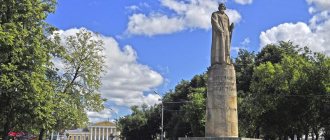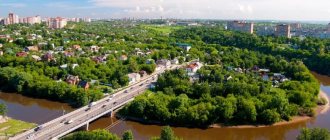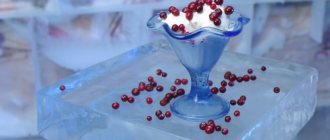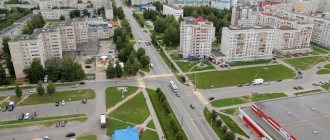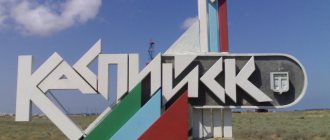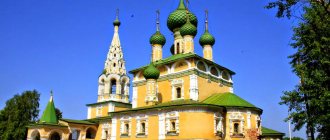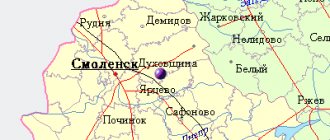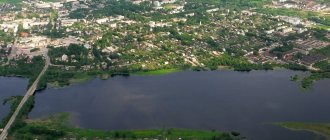View of the fire tower and guardhouse
The center of Kostroma is the huge Susaninskaya Square, which stretches on both sides of Sovetskaya Street. Its northeastern part is affectionately called “Frying Pan” by the people.
The development of the square is a unique, exemplary architectural ensemble of the late 18th-19th centuries. In the very center, by analogy with other regional centers, there is a prime meridian .
Prime meridian in Kostroma
The historical part of Kostroma has a radial semi-circular layout - streets extend from Susaninskaya Square in different directions, like rays of the sun. There is a legend that Catherine II, when asked what she would like Kostroma to be like, unfolded her fan. That’s how the streets were built, according to the empress’s fan-shaped layout. To this day, if you look at Kostroma from above, it seems that there is a huge fan lying there.
Most public transport routes pass through Tekstilshchikov Avenue. There is a trolleybus in Kostroma. But the main carrier is minibuses. The minibus is the main sign of problems with public transport in the city.
Public transport in Kostroma - Trolleybus
Every year, magnificent flower beds are planted on Susaninskaya Square. Patterns of thousands of dahlias, petunias and cineraria appear in the city center.
Flower beds on Susaninskaya Square
And in 2014, not far from the monument to Susanin, an interesting flower garden in the shape of a boat was erected, which Kostroma children and tourists love to climb.
Susaninskaya Square from the Volga side
Past the monument to Susanin, in the fire dog Bobka. This dog lived in the fire department in the 19th century and saved people's lives. Next to the monument there is a ball - a piggy bank, into which anyone can throw a coin as a donation to the City Animal Welfare Center.
Monument to a dog in Kostroma (Bobka)
To the left of the square in Big Flour Rows there is a cheese exchange where you can buy products from the manufacturer. Cheese production is one of the main brands of Kostroma. In general, there is hardly another city like this in Russia with so many well-known brands. Here is a far from complete list: “The cradle of the Romanov dynasty”, “Ivan Susanin is a patriot of the Russian land”, “Kostroma is the pearl of the Golden Ring of Russia”, “Kostroma is the Small Motherland of A.N. Ostrovsky", "Kostroma - the flax capital of Russia", "Kostroma - the jewelry capital of Russia", "Kostroma - the cheese capital of central Russia".
Kostroma is the cheese capital!
Below we will describe in detail the most important attractions of the central part of Kostroma.
Architecture of Kostroma
Susaninskaya Square and the architecture of Kostroma
On Susaninskaya Square in Kostroma there are administrative and commercial ensembles that are among the best examples of Russian provincial classicism of the 18th-19th centuries. They were erected by St. Petersburg craftsmen in accordance with the special “imperial status” of the city, which is why Kostroma is sometimes compared to St. Petersburg.
In the panorama of Susaninskaya Square (from left to right) there is a fire tower, a former guardhouse, the former house of Rogatkin and Botnikov, Borshchov’s house and the Government Building.
Fire tower in Kostroma
Fire tower in Kostroma
An outstanding monument of the Classical era, the 35-meter fire tower has long been an architectural symbol of Kostroma and the highest point in the city center. Arriving here in 1834, Emperor Nicholas I exclaimed enthusiastically: “I don’t even have such a tower in St. Petersburg.” Until the 1990s it remained an active fire station, now transferred to the Kostroma Museum.
Former guardhouse
Kostroma Museum-Reserve (guardhouse)
Next to the fire tower in Kostroma there is a building of the former garrison guardhouse. Today the building is occupied by a branch of the Kostroma State Historical, Architectural and Art Museum-Reserve. Architect P.I. Fursov is the author of these two small architectural masterpieces of the imperial level.
Former house of Rogatkin and Botnikov
Center of Kostroma. Left - Former house of Rogatkin and Botnikov
The three-story brick building in the classicist style (pictured on the left) is the most inconspicuous of the architectural ensemble of Susaninskaya Square. But despite its nondescript nature, the building continues to play an extremely important urban planning role in the ensemble of Susanin Square. Not to mention the historical significance - it was in this house that A.N. Ostrovsky himself and the “moral genius” of Russian literature V.G. lived. Korolenko.
Borschov's House
Former Borschov mansion in Kostroma
Mansion of Borschov N.I. Metlina is one of the largest estates in Kostroma in the first quarter of the 19th century, which has extremely important urban planning significance in the development of the center.
It was in this house that Nikolai Nekrasov, observing scenes from city life, described the monument to Tsar Mikhail Romanov and the peasant Ivan Susanin that stood on Susaninskaya Square until 1918 in his poem “Who Lives Well in Rus'”:
Standing in forged copper, Exactly like Savely’s grandfather, The man on the square, Whose monument? — Susanina
Office building in Kostroma
Office building in Kostroma. Author — Strelnikov Igor
One of the main administrative and public buildings of Kostroma is located at Sovetskaya, 1. In the past - Government places, now - city administration. The structure was created according to the exemplary design of the famous Russian architect A.D. Zakharova. Similar administrative buildings can be seen in other cities of Russia, since the project is standard.
Cheese exchange in Kostroma
Kostroma Cheese Exchange
The Cheese Exchange is located to the left of the square, in Bolshie Flour Rows, pavilion No. 53
In the political sense, Kostroma was not called the capital for long, but to this day it has proudly carried the title of the cheese capital.
At the end of the 19th century, in the village of Andreevskoye, merchant Vladimir Blandov founded the first cheese factory on Kostroma soil. In those days, cheese was a rare and expensive delicacy and it was rarely available to ordinary commoners. But after some time they began to produce it on an industrial scale throughout Russia.
Cheese production on the map of Kostroma province
Today in the Kostroma region there are about 11 large cheese production facilities that produce the famous varieties “Kostromskoy”, “Susaninsky”, “Demidov”, “Voskresensky”, “Ivan Kupala”.
Kostroma cheese
If you are in Kostroma, be sure to check out the Cheese Exchange, which is located on Susaninskaya Square on the Volga side. Here you can try the whole variety of Kostroma cheeses, and buy the product you like at the manufacturer’s price.
Cities through the eyes of residents: unobvious places in Kostroma
Natalya Shumilova
Kostroma is an ancient Russian city that still retains its authenticity. You should start getting acquainted with it from the Trade Rows - drink a cup of excellent coffee with the best croissants in the city at the Coffee Capella coffee shop.
Coffee Capella
Red Rows, 1
Sit at a table outside and enjoy the view of Tobacco and Green Rows.
View this post on Instagram
Posted by Coffee Capella (@capellacoffee)
View this post on Instagram
Publication from Unknown

